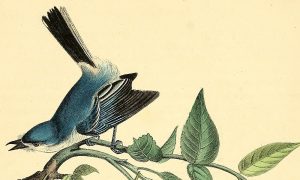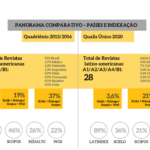By Ronaldo Ferreira de Araújo

For decades, authors have routinely consulted a journal’s impact factor to determine where to submit a manuscript. With the emergence of altmetrics, now the journal’s impact on social media and the relationship it establishes with the public also plays a role in influencing some in selecting a journal. In this sense, social media metrics may act as a type of social-media impact factor and assist the management of a journal’s web presence on platforms such as Twitter and Facebook.
Between July 17 and 20, 2018, the 6th Brazilian Meeting of Bibliometrics and Scientometrics (Encontro Brasileiro de Bibliometria e Cientometria – EBBC) was held in Rio de Janeiro, conducted by the Instituto de Bioquímica Médica, the Faculdade de Administração e Ciências Contábeis and the Sistema de Bibliotecas e Informação da Universidade Federal do Rio de Janeiro, with support from Fundação Oswaldo Cruz. One of the international speakers was Dr. Stefanie Haustein, from the School of Information Studies, University of Ottawa, Canada, co-director of the ScholCommLab and affiliated researcher at the Centre Interuniversitaire de Recherche sur la Science et la Technologie (CIRST) of the University of Québec at Montreal (UQAM). Following her lecture: “Scholarly Twitter metrics: How, when and what does the Twittersphere tweet about science?”, she gave us an interview in which we can address the importance of journal’s web presences in the scope of altmetrics studies, with special attention on Twitter.
This interview continues the discussions made in panel 4.2 – Scientific/academic impact of journals – citation based and other indicators of the SciELO 20 Years Conference.
1. To what do you attribute the prevalence of Twitter in the scientific community regarding the number of tweets on scientific articles as compared to other sources like Facebook and blogs?
The fact that Twitter is exhibiting one of the largest frequency of event counts when it comes to linking to journal articles has a number of reasons. First of all, Twitter is a platform with a large user base: more than 10 million users from Brazil are active on Twitter. Of course, considering Brazil’s enormous population size, that’s merely 5% of people. Worldwide, 4.1 million unique Twitter accounts have linked to at least one scholarly journal article with a DOI.
Compared to Twitter, 11% of journal articles are linked to by Facebook posts, 3% by blog posts and less than 1% are mentioned in Wikipedia articles, as captured by Altmetric. However, one needs to be aware of the discrepancy between data collection and actual amount of Facebook posts: Altmetric only captures public posts, those posts Facebook users who share their information privately, that is, only visible to their friends, are not considered by Altmetric. Therefore, the majority of altmetric studies underestimate activity on Facebook. Data collection by Altmetric and other providers of scholarly metrics is still problematic and incomplete.
2. In your speech, when presenting part of the results concerning how and by whom the papers are shared on Twitter, you present data of the Top three most active users (in number of tweets) and in most cases the journal profiles appear among the most active ones. In your opinion, what is the importance of scientific journals keeping their online presence with social media profiles such as Twitter?
The results pertaining to users who are most active when it comes to scholarly journal articles reveal that we cannot simply talk about societal impact when evaluating tweets and other social media activity in the context of scholarly communication. Most highly active accounts are either fully or partially automated – we consider these bot or cyborg accounts. If tweets linking to journal articles are sent automatically, the question is whether we can actually still talk about any type of impact: what kind of influence does a journal article have when it is sent without human intention? In case of tweets about publications authored by at least one author from a Brazilian institution, the three most active users by number of tweets where arXiv_trend, par_paper and psych2evidence. All three accounts are now either suspended or have been deleted.
Journal or publisher-run accounts are also quite common on Twitter. They often exhibit promotional and marketing activities, where specific content published in the journal is promoted. In my opinion, it is up to the journal if they maintain such an account or not. If they do so, I would sustain from tweeting each and every article but promote a small number of particularly relevant ones, for example, those that discuss a topical issue or several articles discussing the same topic. Of course, from the journal’s perspective, any additional tweet linking to an article is a good tweet, as long as we keep counting tweets without differentiating by user type of tweet content.
3. The hashtag, a structural element of Twitter for content description and classification was also presented as an aspect to be considered in altmetrics studies. What does it offer for altmetrics research and how may it contribute to understanding the contexts of sharing papers on Twitter?
I think hashtags are a particularly interesting affordance to investigate in the context of altmetrics. They usually represent the essence of a tweet – the message boiled down into one keyword or a meeting hashtag to propagate community at an event. In my opinion, although extremely straightforward to analyze content and context of tweeting activity, hashtags are completely under-investigated when it comes to altmetrics.
4. In your study you introduce a novelty by considering the occurrence of emojis in tweets about scientific articles. In your opinion, what is the role of emojis in this context and how can they be understood in altmetrics studies?
Honestly, I had hoped that the use of emojis was more significant, especially since they are so popular on social media and the amount of information they are able to convey in a short amount of message space. However, less than 2% of tweets captured by Altmetric contained an emoji. The most frequently used emojis were pointing (👇, 👈) and liking (👍, ❤) as well as icons related to reading (📚, 👀). Sports-related emojis were particularly popular in tweets from Twitter users in Brazil and tweets to articles authored by Brazilian researchers.
5. At the end of your presentation you make considerations that using Twitter is not considered as social impact; what exactly do you think its use represents within the scope of altmetrics studies?
I definitely stand firm by the conclusion I made in Rio last year (and many of my talks on altmetrics) that social media activity related to scientific journal articles does not represent societal impact. Some tweets linking to scholarly papers might signal the general public’s interest in science and scholarly content, however, as shown above by the dominant role of automated or marketing accounts, much of the activity that we currently consider altmetrics does not reflect any type of impact. It is thus of outmost importance that altmetric research and altmetric applications move forward and differentiate various types of activity and users. More detailed analyses of tweet (and other social media post) content, including hashtags, emojis and geolocation of users, should be the focus of altmetrics in the future. Another under-investigated aspect is also the underlying networks of data which is inherently networks: for example, in a recent paper1 in collaboration with my ScholCommLab co-director Juan Pablo Alperin, we investigated the follower networks of Twitter users linking to the same paper and found interesting patterns using social network analysis. These underlying structures might help us differentiating between lay users and the scholarly community.
Note
1. ALPERIN, J.P., GOMEZ, C.J. AND HAUSTEIN, S. Identifying diffusion patterns of research articles on Twitter: A case study of online engagement with open access articles. Public Understanding of Science [online]. 2019, vol. 28, no. 1, pp. 2-18 [viewed in 11 June 2019]. DOI: 10.1177/0963662518761733. Available from: https://journals.sagepub.com/doi/10.1177/0963662518761733
Reference
ALPERIN, J.P., GOMEZ, C.J. AND HAUSTEIN, S. Identifying diffusion patterns of research articles on Twitter: A case study of online engagement with open access articles. Public Understanding of Science [online]. 2019, vol. 28, no. 1, pp. 2-18 [viewed in 11 June 2019]. DOI: 10.1177/0963662518761733. Available from: https://journals.sagepub.com/doi/10.1177/0963662518761733
External links
Centre Interuniversitaire de Recherche sur la Science et la Technologie (CIRST) <https://www.cirst.uqam.ca/>
ScholCommLab <https://www.scholcommlab.ca/>
School of Information Studies <https://arts.uottawa.ca/sis/>
About Ronaldo Ferreira de Araújo
Ronaldo Ferreira de Araujo is Professor and Assistant Coordinator of the Graduate Program in Information Science of the Universidade Federal de Alagoas (PPGCI / UFAL), Professor of the Graduate Program in Management and Knowledge Organization of the Universidade Federal de Minas Gerais (PPGGOC / UFMG) and Editor of the journal Ciência da Informação em Revista. He is the leader of the Laboratory of Web Information Metrics (Lab-iMetrics), where he develops studies on the cybermetrics and the mediation of web information, digital scientific marketing, and evaluation of academic and social impact of research results using alternative metrics.
About Stephanie Haustein
She is an assistant professor at the University of Ottawa’s School of Information Studies and co-direct the #ScholCommLab, a research group that analyzes all aspects of scholarly communication in the digital age at Simon Frasier University in Vancouver, Canada. She is also an associate member of the Centre interuniversitaire de recherche sur la science et la technologie (CIRST) and an affiliated researcher of the Canada Research Chair on the Transformations of Scholarly Communication, Université de Montréal and the Observatoire des sciences et des technologies (OST), Université du Québec à Montréal. Her research focuses on scholarly communication, bibliometrics, altmetrics and open science and analyzes the role of social media in academia.
Como citar este post [ISO 690/2010]:



















Recent Comments